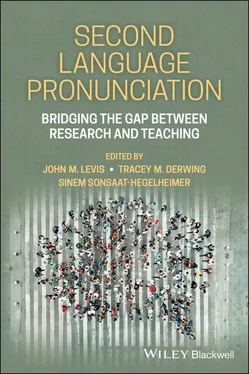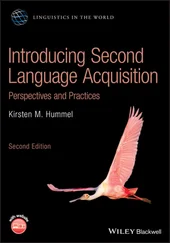Second Language Pronunciation
Здесь есть возможность читать онлайн «Second Language Pronunciation» — ознакомительный отрывок электронной книги совершенно бесплатно, а после прочтения отрывка купить полную версию. В некоторых случаях можно слушать аудио, скачать через торрент в формате fb2 и присутствует краткое содержание. Жанр: unrecognised, на английском языке. Описание произведения, (предисловие) а так же отзывы посетителей доступны на портале библиотеки ЛибКат.
- Название:Second Language Pronunciation
- Автор:
- Жанр:
- Год:неизвестен
- ISBN:нет данных
- Рейтинг книги:5 / 5. Голосов: 1
-
Избранное:Добавить в избранное
- Отзывы:
-
Ваша оценка:
- 100
- 1
- 2
- 3
- 4
- 5
Second Language Pronunciation: краткое содержание, описание и аннотация
Предлагаем к чтению аннотацию, описание, краткое содержание или предисловие (зависит от того, что написал сам автор книги «Second Language Pronunciation»). Если вы не нашли необходимую информацию о книге — напишите в комментариях, мы постараемся отыскать её.
Second Language Pronunciation: Bridging the Gap Between Research and Teaching
Second Language Pronunciation: Bridging the Gap Between Research and Teaching
Second Language Pronunciation — читать онлайн ознакомительный отрывок
Ниже представлен текст книги, разбитый по страницам. Система сохранения места последней прочитанной страницы, позволяет с удобством читать онлайн бесплатно книгу «Second Language Pronunciation», без необходимости каждый раз заново искать на чём Вы остановились. Поставьте закладку, и сможете в любой момент перейти на страницу, на которой закончили чтение.
Интервал:
Закладка:
Pre- and post-intervention listening tests were designed for 30 listeners, who rated speech samples for fluency, comprehensibility, and accentedness. The Drama group exhibited significant improvement in fluency ratings, but no changes were noted in the Comparison group. Both groups improved in comprehensibility over time, although it appears as though the Drama group made slightly more gains. As with many other pronunciation studies, no difference in accent ratings was noted over time.
Debates
Fluency, or the degree to which speakers can talk without pauses, self-repairs, and other disruptive elements, is included in our definition of what pronunciation entails, and it clearly has an impact on comprehensibility. One activity often found in general speaking classes, but which can also contribute to pronunciation, is the debate. El Majidi et al. (2018) undertook a small study in which they introduced debates into language classes. They interviewed the students afterward and asked them to reflect on how their own speech had changed. The students indicated that they had a much better sense of how to pronounce new vocabulary. In a follow-up study, the same authors (El Majidi et al. 2021) examined the effects of an intervention employing debates compared to a control group, and found many significant improvements in the experimental group. Although they did not examine pronunciation of segments and suprasegmentals, they did measure fluency, which was significantly enhanced by debate; we know from other research that improvements in fluency in slow talkers result in an increase in comprehensibility (Munro & Derwing, 1998). The learners read about their topic, prepared their position in writing, and then prepared their speaking points.
Pragmatic Speech Acts
Derwing et al. (2021) hypothesized that predictability in speech contributes to overall comprehensibility. They tested this by teaching the pragmatics of four speech acts (compliments, requests, polite refusals, and apologies) to intermediate learners of English through the use of role-plays. Aspects of each speech act were taught explicitly; for instance, requests were broken down into Interruptions ( Do you have a minute?/Sorry to interrupt ), Explanations ( The school called and my child is sick ), Requests ( Can I leave a bit early to pick him up? ) and Solutions ( I can make up the time tomorrow ). The students watched videos of appropriate and inappropriate speech acts, and then practiced scenarios on their own. They were in turn video-recorded, and they watched each other’s role-plays and offered suggestions for improvement. The students were deeply engaged with the classes, and felt as though they were learning “the flow of Canadian speaking, which is different from back home speaking” (p. 124). Pre- and post-recordings of two requests and two polite refusals (considered the most difficult of the speech acts taught) were played to listeners who rated them for social appropriateness, comprehensibility, and fluency. All four scenarios were rated as significantly more socially appropriate after instruction. All but one of the scenarios was rated as significantly more comprehensible, suggesting that predictability does make it easier for listeners to process L2 speech. Only one scenario was rated as significantly more fluent post-intervention; one was significantly less fluent, and two were unchanged. The authors attribute this finding to the relative difficulty of negotiating the pragmatics of these speech acts.
Where to Start
This volume is rich with ideas from research that can inform pronunciation instruction in the classroom. Empirical studies offer extremely helpful ideas to teachers, and they provide insights as to why certain activities will have beneficial outcomes. However, knowing about some new activities and understanding why they may be useful is likely not enough to encourage a teacher who has not had any training in pronunciation to try implementing some of these ideas. The first step is always to determine where students’ pronunciation problems lie, and this is often the most difficult.
We suggest not doing this alone; a new endeavor will be easier to undertake with one or two colleagues. In one of the first classes in a language course, students should be asked to send a short (2–3 minutes) recording to their teacher on an easy topic such as “My favorite food” or “my happiest moment” or “my daily routine.” Teachers could also ask their students to describe a picture and send the recording. To assess where intelligibility and comprehensibility problems lie, two or three teachers should listen to these recordings together. Listening for specific aspects of speech helps to isolate problems – “once for overall comprehensibility, once for word stress, once for sentence stress, once for vowels, and finally consonants” (Derwing, in press). When each student’s most difficult problems have been identified, it is time to make a plan for both in-class and homework activities. (Note that some students may not have any features in their speech that interfere with comprehensibility.) If several students share specific difficulties, then classroom activities can be considered (often suprasegmentals will fall into this category). If individual students are struggling with certain segments, the teacher must then determine if the problem is related to perception, production, or both by doing a simple perception test. For example, if a student produces a /b/ where a /p/ is warranted, teachers can display a minimal pair, and produce one of the words. If the students can perceive correctly, then their problem is strictly production. If they cannot, then explicit explanation, along with listening practice can be introduced. Much of the listening practice can be done at home on a website such as English Accent Coach (Thomson, 2021) and students’ scores can be forwarded to the instructor.
This may seem like a daunting undertaking, but it is far less onerous if two or more teachers do it together. To trace their learners’ progress, teachers may want to conduct an informal action research project. Burns (2009) provides guidelines on how classroom teachers can systematically keep track of pronunciation activities, ensuring spiraling for optimal exposure. Burns provides a very clear example of one language teacher’s approach to action research that follows a cycle of “planning, action, observation and reflection” (115). It isn’t necessary to undertake action research, but reading about the process may provide teachers with ideas for structure that hadn’t occurred to them before.
We hope that the chapters here will bridge the gap for teachers who are uncomfortable teaching pronunciation in the language classroom. In the words of Yates and Zielinski, “Give it a go!”
Practical Resources for Pedagogy and Research
Derwing, T. M. & Munro, M. J. (2015). Pronunciation fundamentals: Evidence-based perspectives for L2 teaching and research . Amsterdam: John Benjamins.
This book covers the how, why, and when of teaching pronunciation by examining empirical research outcomes and making pedagogical recommendations.
Jones, T. (Ed.) (2016). Pronunciation in the classroom: The overlooked essential . Alexandria, Virginia: TESOL Press.
The chapters in this edited volume are written by well-known experts. They discuss the integration of pronunciation teaching within several other linguistic foci such as vocabulary, listening and speaking, presentations skills, grammar, reading, spelling, and punctuation.
Levis, J. M. (2018). Intelligibility, oral communication, and the teaching of pronunciation . Cambridge University Press.
The field of pronunciation teaching has swung from an unnecessary focus on accuracy to a more reasonable goal of intelligibility. This volume is the most in-depth examination of intelligibility and how it matters to pronunciation.
Читать дальшеИнтервал:
Закладка:
Похожие книги на «Second Language Pronunciation»
Представляем Вашему вниманию похожие книги на «Second Language Pronunciation» списком для выбора. Мы отобрали схожую по названию и смыслу литературу в надежде предоставить читателям больше вариантов отыскать новые, интересные, ещё непрочитанные произведения.
Обсуждение, отзывы о книге «Second Language Pronunciation» и просто собственные мнения читателей. Оставьте ваши комментарии, напишите, что Вы думаете о произведении, его смысле или главных героях. Укажите что конкретно понравилось, а что нет, и почему Вы так считаете.












